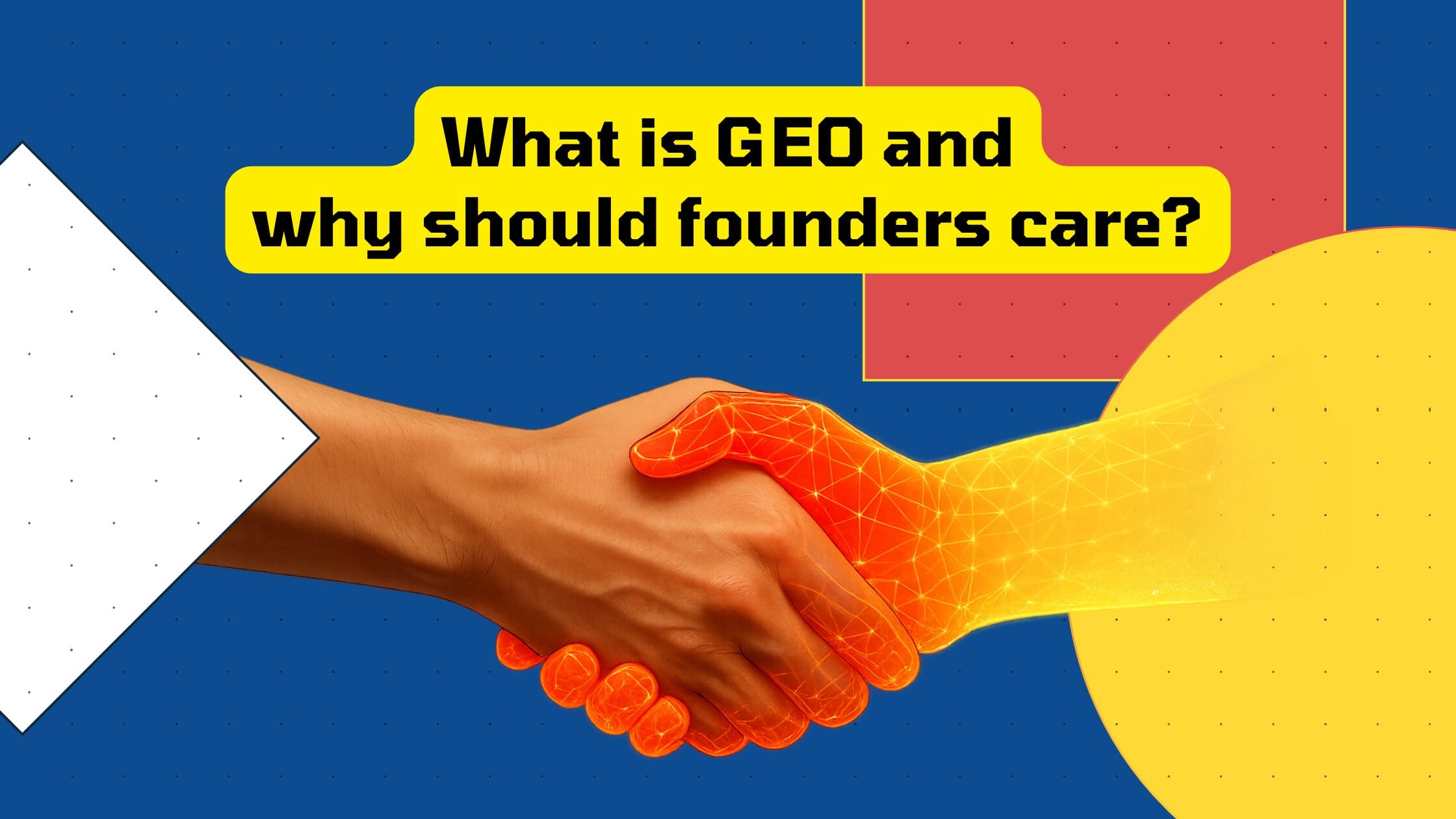Table of contents
Generative Engine Optimization (GEO) is the process of making your brand visible and citable in AI-generated answers, so LLMs like ChatGPT, Gemini and Perplexity can accurately reference your company in recommendations and insights.
Artificial intelligence now significantly shapes how potential buyers discover and assess software options. The numbers speak for themselves: early GEO adopters have found that visitors arriving through AI recommendations convert at rates far higher than standard organic traffic, with our study reporting a 20-25% conversion rate from ChatGPT compared to organic search.
But successful implementation requires deep understanding of both the specific signals that influence AI systems and the precise content structures that facilitate AI citation.
TLDR
- What is GEO? Generative Engine Optimization is the practice of making your brand more likely to be cited in AI-generated answers, not just ranked in search results.
- AI Prioritizes Contextual Relevance: Generative engines assess entities, their relationships, and the trustworthiness of sources to determine relevance.
- Strategic Signal Building: A balanced approach combining internal entity clarity, strategic brand mentions, and high-context external links is essential for effective GEO.
- Structured Content is Crucial: Organizing content with clear definitions, schema markup, and branded anchor text enhances AI’s ability to extract and cite your brand accurately.
Why GEO Matters for B2B SaaS Buyer Journeys
Instead of relying solely on traditional Google searches or direct engagement with sales reps, B2B buyers are increasingly turning to AI assistants and generative search tools to research software options. In fact, buyers now spend the majority of their time researching independently, and AI is quickly becoming one of the top sources of self-guided information.
Major platforms like Google are accelerating this change by rolling out AI-first search capabilities, making AI-driven search a vital channel for reaching potential customers.
These AI systems deliver highly tailored recommendations that drive exceptional results, with our early data revealing conversion rates of up to 30% from AI-referred visitors compared to just 3% from traditional search traffic.
This shift is especially critical for SaaS. According to Gartner, by 2030, as much as 20% of business revenue could be influenced by automated purchasing systems. As enterprises adopt these technologies, the same behaviors are expected to filter down to B2B and consumer markets. With Millennials and Gen Z making up 65% of B2B decision-makers (generations already comfortable with AI-enabled and self-service buying) the move toward AI-driven purchasing is accelerating.
At the same time, AI is reshaping how buyers interact with brands throughout the journey. Generative systems personalize experiences by analyzing real-time behaviors, recommending relevant features, providing instant access to demos and pricing, and surfacing tailored suggestions. Research also shows that brands appearing in AI-powered searches gain a significant advantage, with AI-driven recommendations influencing buying decisions at a higher rate than traditional search.

Source: Neil Patel
Although traditional SEO remains a necessary foundation, it is no longer sufficient for securing visibility in this new landscape. GEO complements SEO by optimizing for AI-specific signals such as entity clarity, contextual mentions, and trusted co-citations, ensuring your brand is recognized, trusted, and recommended by AI systems. For SaaS companies, this means building a competitive edge where it matters most: capturing high-intent buyers precisely when they are making purchasing decisions.
So, to make the most of GEO, it’s important to understand how generative engines assemble answers. By grasping the mechanics you can align your content and external signals with the way AI evaluates relevance.
How Generative Engines Assemble Answers
Before diving into the tactics, it helps to understand the key signals generative engines use to determine relevance and trust:
- Entity Recognition
First and foremost, AI must clearly identify each entity in a query: your brand, your competitors, and the product categories involved. This process, known as named entity recognition (NER), is critical for disambiguation. The model needs to recognize, for example, that your company name refers to a B2B software platform and not an unrelated product or business in a different industry. - Co-occurrence and Contextual Clustering
Generative engines track how often your brand appears alongside relevant terms (co-occurrence) and how those terms group together in meaningful clusters (contextual clustering). For example, if your company is consistently mentioned with concepts like ‘workflow automation,’ ‘API integrations,’ and ‘user provisioning’ in reputable sources, AI will infer a strong semantic relationship. - Source Trust
Finally, AI models assess the credibility of sources based on various trust signals, including publication reputation, authoritativeness of the domain, and domain-specific expertise. When multiple high-trust documents cite your brand together, it strengthens the case for AI citations. This aligns with Google’s E-E-A-T (Experience, Expertise, Authoritativeness, and Trustworthiness) framework, which emphasizes the importance of trust in determining content quality and relevance.
In effect, GEO is the art and science of building enough entity clarity, contextual breadth, and trusted co-citations that AI assistants can confidently answer buyer questions with your brand front and center.
From Ranking to Citing: The Rise of GEO
For decades, SEO focused on crawling, indexing, and ranking pages to capture clicks. Backlinks and keywords determined visibility, and page-level authority decided which sites appeared in search results.
GEO works differently. When an AI assistant answers a question, it doesn’t show a list of links, it extracts and assembles information from multiple trusted sources, highlighting specific brands or recommendations. Generative engines prioritize answer-level relevance, analyzing entities such as your brand, product categories, and unique capabilities. They also track how these entities relate to each other and assess the trustworthiness of sources before selecting citations.
In practice, GEO is about making your brand recognizable and citable in AI-generated answers. Even small, focused signals, like meaningful mentions in the right context, can significantly influence how AI systems reference your company.
This shift from ranking to citing isn’t just a technical change, it directly reflects how today’s B2B buyers are making decisions. With the majority of research now happening independently and AI tools guiding evaluation, being cited in generative answers has become as critical as ranking once was in Google. For SaaS companies, this means the next competitive edge lies not in chasing keywords, but in ensuring your brand is consistently recognized, trusted, and referenced by AI systems. This shift makes a GEO-first approach the logical next step.
A GEO-First Signal Building Roadmap
Generative AI systems actively select which brands to reference in their responses. This means you must intentionally craft the signals these systems rely on. Effective Generative Engine Optimization (GEO) goes beyond mere visibility, it transforms your brand into a trusted authority that AI confidently cites. The process requires building strong internal foundations first, then establishing valuable external signals, and finally implementing continuous refinement strategies. Rather than pursuing fleeting rankings, focus on creating an environment where AI systems consistently mention your brand in their answers.
This roadmap ensures your brand becomes a recognized, trusted reference point in the AI ecosystem.
1. Build a Strong SEO Foundation
Although GEO extends beyond traditional search, a solid SEO base ensures AI systems can discover and interpret your content. Focus on technical SEO, site speed, crawlable pages, and a clear URL hierarchy. A well-structured site allows generative engines to access your content efficiently.
2. Establish Internal Entity Clarity
Audit your site to create hub pages for each core topic, with clear definitions, concise headings, and schema markup. Link all related content back to these hubs using branded anchor text, building an authoritative network that clarifies your entities: people, products, and places, for AI comprehension.
3. Structure Content for AI Comprehension
Organize your content so AI systems can easily extract citations and understand your brand, products, and expertise. A clear, disciplined structure significantly boosts the odds of your content being featured in AI-generated answers. As Search Engine Journal explains, clarity, formatting, and logical hierarchy are key for making content both human-readable and AI-friendly.
- Define the topic scope at the top: Place your TL;DR or main takeaway early. Avoid making AI models or users scroll through hundreds of words before reaching the core insights.
- Lead with the main insight: Start each paragraph with the key point or answer. AI prioritizes prominent, clearly stated information.
- Focus on one idea per paragraph: Avoid mixing multiple concepts; this helps AI disambiguate entities and associate the correct attributes with your brand.
- Use semantic cues in the body: Phrases like “in summary,” “the most important,” “step 1,” or “common mistake” act as markers for AI to identify structure and relevance, improving citation accuracy.
- Highlight definitions and proprietary data: Place definitions, unique product details, and original statistics where they are easy to identify. AI models are more likely to cite content that clearly explains concepts.
- Use structured headings and anchor links: Organize sections logically and use descriptive headings to create a content hierarchy AI can navigate. Anchor links for sub-topics improve parsing of related information.
- Implement structured data: Apply FAQ, HowTo, or Article schema to make pages machine-readable and ensure AI can extract citations reliably.
- Keep natural language and conversational tone: Mirror how people ask questions, increasing the likelihood your content is surfaced in AI answers.
4. Lock Down Strategic Brand Mentions
Secure placements on trusted, peer-reviewed platforms like G2, Capterra, and TrustRadius, along with product comparison pages, industry directories, and even unlinked mentions. Collectively, these signals help AI recognize your brand within key categories and strengthen trust. In fact, an Ahrefs study of 75,000 brands found that brand mentions show the strongest correlation with visibility in AI Overviews.
5. Pursue High-Context External Links
Identify reputable industry publications, blogs, and analyst reports covering your core themes. Use data-driven PR, co-branded research, and thought-leadership content to earn coverage. These links strengthen traditional SEO while also serving as contextual signals that generative engines use to co-cite your brand alongside industry-defining topics. Push for branded anchor text when possible.
6. Leverage Conversational and Natural Language
Write in a way that mirrors how people actually ask questions. Because generative engines are trained on conversational text, natural phrasing makes your content far more likely to appear in AI-generated answers. A recent guide to GEO emphasizes this point, noting that the most effective content is written as if you’re speaking directly to your audience: “write like you talk, not like you sell”.
7. Build Reputation and Authority
Consistency matters. Repeated mentions, co-citations with trusted entities, and recognition in authoritative sources reinforce your brand as a reliable reference. This strengthens AI confidence in recommending your solutions.
8. Analyze AI Outputs and Refine Strategy
Monitor how AI systems cite your brand, which competitors appear alongside you, and how your content is interpreted. Treat these AI-generated answers as a feedback loop; each output provides insight into how the engine understands your entities and which signals may be missing. Tools like HubSpot’s AI Search Grader can help you analyze your brand presence in AI search results, understand your sentiment and share of voice, and identify areas for improvement.
9. Convert Links into Mentions, and Mentions into Links
Whenever possible, transform press coverage, proprietary research, and social engagement into both backlinks and unlinked mentions. This cascading effect amplifies your brand’s visibility across multiple sources and strengthens the semantic connections AI relies on.
Bottom Line
Generative Engine Optimization (GEO) is no longer optional, it’s how SaaS companies ensure their brand is recognized, trusted, and cited in AI-generated answers, rather than merely ranked in search results. The main takeaway is clear: to capture high-intent buyers in this new AI-driven landscape, you must actively shape the signals that generative engines rely on, including entity clarity, contextual mentions, and co-citations in authoritative sources.
The implication is significant. Early data shows that AI-referred visitors can convert at rates many times higher than traditional search traffic. By mastering how AI interprets and prioritizes information, you position your brand to meet buyers exactly when they’re ready to purchase, influence market perception, and build lasting competitive advantage.
For SaaS founders who have just learned the fundamentals of GEO, the next step is to translate understanding into action. Start by deepening your knowledge in specific areas and exploring practical applications:
- GEO myths and facts — Separate hype from actionable strategies.
- The best GEO agencies for SaaS — Evaluate partners who can accelerate your efforts.
Take the next step and put GEO into action. Singularity Digital helps your SaaS brand stay visible, trusted, and influential in the AI-driven buying journey.



